
Candy Cane
Peppermint, Mentha piperata.
Peppermint doesn’t really get the respect it deserves, in my estimation. It’s commonly found in most herb collections and many people eschew it due to its invasive habit.
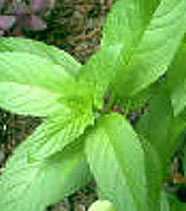
Peppermint Leaves
And, it’s not new! Or exotic! Or called a SuperFood.
But! Peppermint is a herb for all around use! I hope you long-time herb lovers will find new information here. And for those of you who have recently discovered the wonderful world of herbs, you will find some ways to use peppermint you weren’t yet aware of, growing tips and other useful information.
Description
Peppermint is a perennial mint with coarsely serrated leaves which can reach more than 2 inches (5 cm) in length. The stems are square and can be from green to reddish in color. The flowers are pink to red, form in the leaf axils of the upper leaves and are placed in whorls of loose spikes. The whole plant can reach to 36 inches (1 m) high in a favorable environment.

Botanical Drawing of Peppermint
True Peppermint is a sterile hybrid between Water Mint, M. aquatic and Spearmint, M. spicata.
This means that Peppermint does not produce viable seed. So if you see Peppermint seed for sale, you will not get true Peppermint by growing it out, but, rather, a form of Spearmint with, often, a less than pleasing aroma and taste.
Because the mints which make up Peppermint are themselves somewhat variable, not all Peppermint smells or tastes the same. If you find a Peppermint that you really like, the best way to keep it going is through vegetative propagation: stem or root cuttings, ground layering or division.
Other Mints in the Peppermint Family
Mints in general are very promiscuous, crossing with each other when in flower at the same time. This habit can cause your mints to lose character over time, so if you have a mint you especially like, keep it isolated from its brethren, or you may lose the properties of it that you like the best. The following are either found cultivars or man-made ones that are popular.
Orange Mint, Mentha piperata f. citrata ‘Orange’– Hardy perennial grows up to 32 inches (30 cm) with an indefinite spread. Small, pale pink flowers. Large rounded leaves, oval, dark green, can be tinged with purple. Citrusy scent.
Black Peppermint, Mentha piperata– Hardy perennial grows up to 2 feet, (60 cm), leaves pointed, oval and toothed on the margin, dark plum brown tinged with green.
Grapefruit Mint, Mentha X piperata var. citrata has very rounded, fuzzy leaves, grows taller than many other Peppermints and has a citrus-like flavor.
Chocolate Mint, is a cultivar of Peppermint that smells and tastes somewhat of chocolate. It is a favorite for sauces to be served over ice cream. It has shiny, dark green leaves and dark stems.
Cultivation
Most mints are easy to grow and Peppermint is no exception. In fact, many people consider it a garden pest if it escapes into the landscape. Of course, that definition is in the eye of the beholder. If you really like Peppermint Tea or want to make Peppermint Essential Oil, you’ll need lots of Peppermint leaves, so a rambling plant may be just what you need. If not, mints grow quite well contained in pots or hanging baskets.
Peppermint likes cool moist roots and to grow into the sun. If you live in a desert area or the hot, humid Gulf Coast South, as I do, mints can tend to fail in the heat of the summer. My recommendation is to grow your mint where the plant gets morning sun and afternoon shade, especially in the summer. Under a deciduous tree is perfect- Winter sun, Summer shade.
If you’re growing your mint in a container, you can give it lots of Winter and early Spring sun, then move it to a spot where it’s shaded from the searing late summer sun. Or… you can move to Seattle or Milwaukee or Pittsburg and grow your mint in full sun where it will thrive and try to take over the neighborhood.
Peppermint is hardy to Zone 5 and grows in a wide range of soils. It likes water and does well where herbs that need better drainage will not do well. I’ve seen it growing happily under the drip of a room air conditioner or near a faucet in the garden. In containers, it still needs decent drainage. Don’t neglect to water it.
For best results with Peppermint, it’s best to divide and replant an established plant every 3 to 4 years. Cut plants back after flowering to encourage new leaf growth. Leave the flowers until they fade, though, as they attract butterflies and beneficial insects such as hover flies to the garden. In high heat areas, cutting your Peppermint back in late summer will cause fresh, new growth to come out once the fall weather arrives and you’ll have a new crop to harvest.
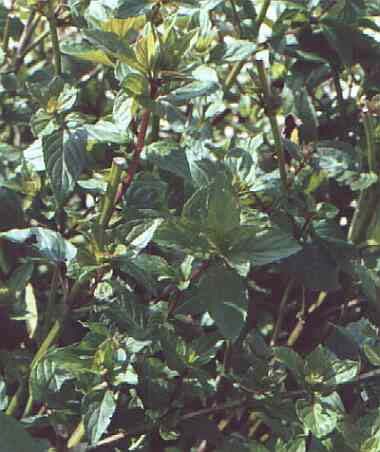
Healthy Peppermint Plant
Plant Problems
There are diseases which attack the Peppermint plant. The worst seems to be a fungus, Puccinia mentha, sometimes known as ‘mint rust’. It causes rusty colored spots on the leaves which grow to take over the whole leaf. If you have this issue, it’s best to destroy the plant. Most home compost piles don’t get hot enough to destroy the fungus, so it’s best to bag the plant and place it in the trash. If you live where you can burn outdoors, one way to destroy the plant and sterilize the soil where it was growing is to cover the plant with dry straw or hay and set it alight. If you cannot do this, don’t plant mint in the same area where the affected plant was growing. If rust occurs in a potted plant, toss the soil and sterilize the pot. Again, use the pot for something that isn’t affected by the rust, just to be safe.
History
Peppermint is native to the Mediterranean and North Africa. In Ancient Egypt Peppermint was used to aid in the relief of stomach pains. During Biblical times it was used as a medium of monetary exchange and for payment of tithes.
In Greek mythology, the story of how Peppermint got its characteristics goes something like this:
Minthe was a river nymph in the Cocytus River (one of the five rivers of Hades). When Hades was driving his golden chariot, he came upon Minthe and was about to seduce her when his wife Persephone caught them. Persephone then turned Minthe into a lowly mint plant that people would walk upon. Mint supposedly got its pungent, sweet smell when Hades softened the spell so that when people walked upon his lover they would smell her sweetness.
Peppermint gets the descriptor piperita from the particular peppery, pungency that distinguishes it from other members of the mint family.
Uses
Peppermint has been a favorite strewing herb due to its bright aroma when crushed underfoot. Peppermint is said to lend an atmosphere of cheer and optimism, so a cup of Peppermint Tea is refreshing as a pick me up.
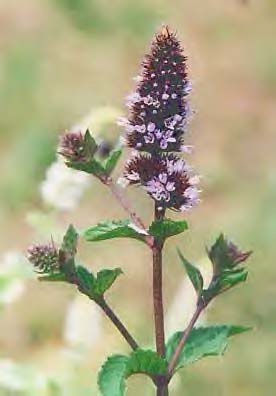
Peppermint Flower
Scrubbing a wooden table with peppermint leaves is an old use for the herb. This practice would leave the table with a clean, fresh scent that would aid the appetite. It was also considered a mark of hospitality.
In aromatherapy, Peppermint animates and energizes the spriit, bringing a feeling of brightness and clarity.
A tea made from Peppermint leaves is said to relieve symptoms of fever: boil 1 pint water, add 1 tsp each dried peppermint, yarrow, elderflower, remove from heat, steep 10 minutes, strain and serve.

Peppermint Tea
It is a refreshing bath herb and can relieve rashes from chicken pox, while the analgesic properties help with body aches from fever.
Facial steam– boil some water in a saucepan, add some mint leaves- dried or fresh- place towel over the head and the pan and allow the steam to infuse your skin for about 10 minutes.
Peppermint contains menthol, among other essences, which is a mild antiseptic. It makes a good addition to a salve. It has many commercial uses as flavoring in toothpaste, soaps, indigestion tablets, candies, chewing gum, cough syrup and other preparations. Peppermint oil is used in rubs and liniments due to its effectiveness as a local anesthetic. It increases the sensitivity of the receptors in the skin that perceive the sensation of coolness and reduces the sensitivity of the receptors that perceive pain and itch.
Menthol is also a counterirritant, an agent that causes the small blood vessels under the skin to dilate, increasing the flow of blood to the area and making the skin feel warm. When you apply a skin lotion made with menthol, your skin feels cool for a minutes, then warm, which is why it’s used in rubs for sore muscles. Menthol’s anesthetic properties also make it useful in sprays and lozenges for sore throats.
Peppermint Tea and mints have been served as after dinner fare not only to freshen the breath, but to also aid in digestion. 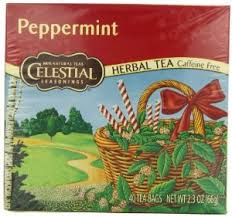
Peppermint has been found to smooth the long muscles surrounding the stomach and intestines, which is how it aids in digestion. It allows the stomach and intestines to do their job more effectively.
PEPPERMINT ESSENTIAL OIL RECIPE
If you have access to lots of fresh peppermint, you can make essential oil. The leaves contain up to 4% oil, which can be removed by solvent extraction. Pick 2 cups of fresh peppermint leaves. Gently rinse them to remove any pesticides or spores. Pat them dry with a paper towel and allow to air-dry overnight on a rack (this prevents mold growth). Loosely fill a glass jar with leaves, then fill it with vodka.
Close the jar tightly and keep it in a cool, dark place. Shake gently every day for two weeks, then strain into a clean jar. Use cheesecloth to squeeze extra liquid from the leaves. Discard the leaves, and put the jar of liquid in your freezer for three hours. The essential oil will freeze, the alcohol will not. Carefully pour the alcohol into a clean jar for the next batch. Store the oil in glass in a cool, dark place.
Do not use Peppermint Essential Oil undiluted. It is very strong and can burn the skin. Use the oil as medicine, as flavoring, or in soaps, perfumes, massage oils, and bath salts.
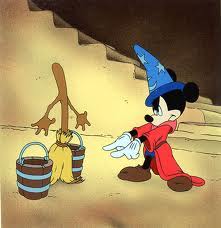
The ultimate in floor washing!
Peppermint Floorwash: Make a strong infusion of peppermint by pouring boiling water over the dried botanical. When it cools, strain out the peppermint and add the liquid to a bucket of floorwash rinse water. Add vinegar. Cleanse the floors and threshold areas to radiate an invitation to happiness and good fortune.
Culinary Use
In the U.S., Peppermint is mostly used in tea. It makes a light green tea with a bright and minty flavor. It is easily combined with other herbs such as lemon balm, rose hips, hibiscus or any other herb you like to use in tea. It can also be added to black or green tea to perk up either hot or iced tea.
Many people find the spicy flavor of Peppermint too strong in uncooked foods, such as Tabouleh, for instance, the Middle Eastern popular bulgher wheat dish, where Spearmint is a better choice. But Peppermint does well in cooked dishes and drinks.
Chocolate Peppermint Muffins
- 4 cup all purpose flour
- 1 3/4 cup cocoa
- 2 1/2 cup sugar
- 1 1/2 tsp baking soda
- 1/2 cup ground dried peppermint or 3/4 cup finely
- minced and crushed fresh peppermint
- 1 1/3 cup oil
- 4 eggs
- 1 1/2 cup buttermilk
- 1 Tbsp vanilla
- 1 1/2 cup mini-chocolate chips
Mix together flour, cocoa, sugar, baking soda, baking powder, peppermint (if using dry) and chocolate chips.
Set aside.
Mix together peppermint (if using fresh) oil, eggs, buttermilk and vanilla.
Pour wet ingredients into the dry and mix all together just till moistened.
Fill paper lined or greased muffin cups 3/4 full.
Bake at 375F just till tops spring back 15-20 minutes. Test often as the “brown” muffin color doesn’t show if it is overbaked.
Makes 18.
(Madison Herb Society Cookbook)
In Conclusion
Whether you grow herbs for culinary use, medicinal or health reasons, to attract beneficial insects to your garden or as ornamentals, Peppermint deserves a place in your garden. It’s bright and cheery aroma can be had simply by plucking a leaf, crushing it between your fingers and holding it to your nose. If your garden is formal in appearance, Peppermint still has a place in a container. Trimmed occasionally, it has a lovely appearance. The crinkled, dark green leaves add interest to the garden palette.
I hope you find your way to adding Peppermint to your herb collection. You’ll be glad you did.
![]()
Herb Liqueur #2
- 1 fifth brandy
- 1 sprig (large) sweet basil with flowers
- 1 sprig parsley
- 1 sprig (small) lovage
- 8-10 sprigs peppermint
- 1 sprig (leaves only) bee balm
- 1 sprig (leaves only) pineapple sage
- 4 sprigs spearmint
- 1 fresh bay leaf
- 3 sprigs oregano with flowers
- 3 young fennel leaves
- 1 fist full of lemon thyme and winter savory
- 8 allspice berries
- 1/2 tsp coriander seeds (crushed slightly)
- 1/2 tsp dried orange peel
- 2 cups sugar
Mix all ingredients in glass jar and steep for 4-6 weeks. Stir or shake daily until sugar is dissolved. Strain, decant and rebottle. This has sugar added with the herbs and spices. It’s a little sweet and thick. Serve it mixed 50/50 with plain brandy on ice or on its own over ice.
(The Madison Herb Society Cookbook)
Bibliography:
- Big Book of Herbs, Tom DiBaggio, Art O. Tucker
- Wild and Weedy Apothecary, Doreen Shababy
- http://peppermint.indepthinfo.com
- 2013 Herbalpedia, Herb Growing & Marketing Network, Maureen Rogers, herbadpedia.com
![]()
QUOTE FOR THE MONTH
Life is like a ten-speed bike. Most of us have gears we never use.
-Charles Schulz, cartoonist (1922-2000)
